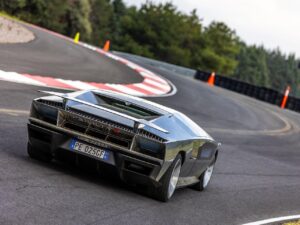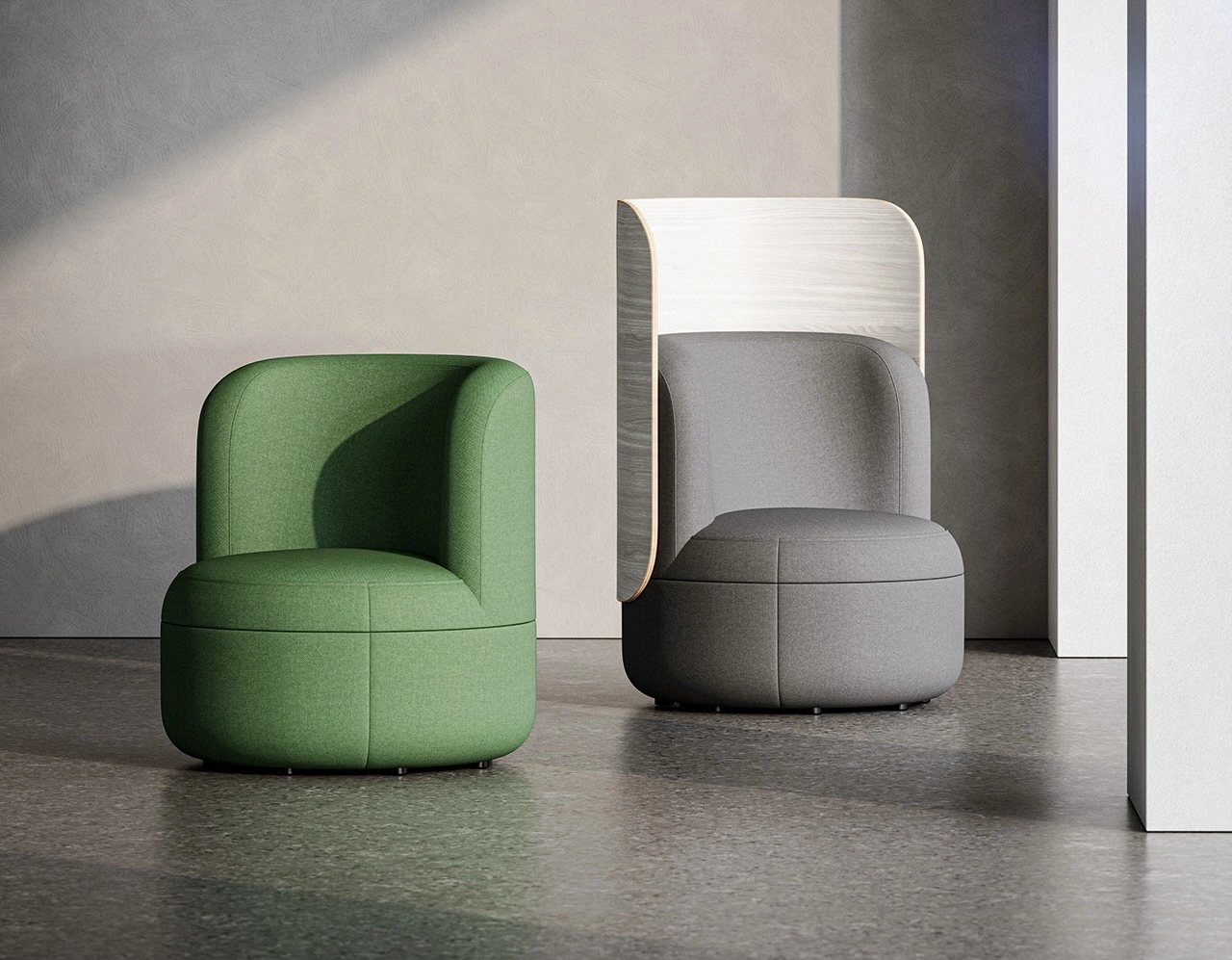Close your eyes and imagine a laptop. Chances are, you picture a sleek, aluminum-clad MacBook Air, something so impossibly thin and elemental that it almost disappears when you look at it from the side. Now, close your eyes and picture a car. You might think of something aerodynamic, a low-slung silhouette, but likely not a wedge-shaped slab of pure geometry slicing through the air.
This is where the Peralta S enters — or rather, pierces — the conversation. It is a car that refuses to conform to contemporary automotive design trends that rely on muscular haunches, busy surfaces, and gratuitous vents. Instead, it takes a stance that’s radical yet deeply logical: less is infinitely more. In a world obsessed with ever-increasing complexity, the Peralta S dares to suggest that the ultimate expression of sophistication might just be simplicity.
An Homage to a Legend
To truly understand the Peralta S, we must first revisit the 1972 Maserati Boomerang, Giorgetto Giugiaro’s daring design that looked more like a spaceship than a car. When it was unveiled at the Geneva Motor Show, the Boomerang was met with slack-jawed astonishment. Its lines were impossibly sharp, its silhouette shockingly geometric. It was a manifesto on wheels, a bold declaration that the future was angular, clean, and uncompromising.
Fast-forward to the 2020s, and the world of automotive design has largely moved away from such audacity. Even supercars, those supposed flag-bearers of automotive excess, have become so preoccupied with performance metrics and aerodynamics that their forms have become overworked and noisy. Enter Fabrizio Giugiaro — son of Giorgetto — who decided to pick up the torch and push minimalism into the 21st century.
Fabrizio Giugiaro’s Design Philosophy
Fabrizio has always had the impossible task of emerging from his father’s enormous shadow. Giorgetto Giugiaro isn’t just another designer; he is the mind behind icons like the DeLorean DMC-12, the Lotus Esprit, and countless Volkswagen, Alfa Romeo, and Maserati models. Fabrizio grew up in the orbit of this design galaxy, absorbing lessons that would later crystallize into his own distinct philosophy.
With the Peralta S, Fabrizio steps out from that shadow not by imitating but by evolving. His goal was not to simply resurrect the Boomerang but to interrogate its essence. What made it so radical? Why did it resonate so deeply? And, most importantly, how could that spirit be relevant today?
The Peralta S answers these questions with a visual language that is as pure as it is dramatic. The entire car is defined by a single, unbroken line that runs from its sharp nose to its abruptly truncated tail. There are no unnecessary surface breaks, no tacked-on spoilers, no ducts screaming for attention. It is a study in restraint and purity — a rolling sculpture that invites you to reflect as much as it demands you to stare.
Engineering Meets Art
Of course, minimalism isn’t merely an aesthetic exercise. To pull off something this elemental in an actual, functioning vehicle requires engineering wizardry. The Peralta S is a masterclass in integrating structural and aerodynamic requirements without compromising the design purity.
Beneath its stark exterior lies a monocoque chassis crafted from carbon fiber reinforced polymer (CFRP). This ensures not only extreme rigidity but also keeps the overall weight impressively low. The car’s flat, low profile is not merely a stylistic flourish; it drastically reduces drag, helping it slip through the air with almost eerie efficiency.
The wheels are pushed to the absolute corners, creating a planted stance and maximizing interior cabin space — though “cabin” might be too generous a word for the intimate, fighter-jet-like cockpit of the Peralta S. There’s an almost devotional commitment to keeping visual noise at bay; even functional elements like the door seams and air inlets are meticulously integrated, almost hidden.
Power and Performance
But don’t let the minimalist philosophy fool you — the Peralta S is no mere design study or art object destined for static display. Underneath its severe skin lies a powertrain worthy of its radical looks. A mid-mounted, naturally aspirated V10, tuned to deliver a spine-tingling 850 horsepower, propels the car forward with unfiltered ferocity.
Fabrizio insisted on a naturally aspirated engine, bucking the trend of hybrid and turbocharged setups that dominate modern supercars. His reasoning is both poetic and practical: a naturally aspirated engine offers a visceral, immediate connection to the machine, free from the filters and delays that characterize forced induction systems.
Acceleration is brutal — 0 to 60 mph in under 2.5 seconds — but it is the way the Peralta S delivers its power that sets it apart. Every throttle input feels like a conversation with the car’s soul, every downshift a reminder that this is a machine meant to be driven, not just admired.
An Interior as Radical as the Exterior
Step inside, and the design language remains unwaveringly consistent. The cockpit is an exercise in reduction. There are no screens, no sea of buttons, no superfluous ornamentation. Instead, a single horizontal binnacle displays essential information, rendered in crisp, minimalist typography.
The seats, sculpted directly into the carbon monocoque, are covered in a single swath of hand-stitched leather, dyed in deep, inky hues. The steering wheel, more akin to an aircraft yoke, underscores the idea of the car as an extension of the driver’s will.
All tactile surfaces are finished in raw metal, leather, or Alcantara, avoiding the glossy plastics and garish trim pieces that plague even some high-end cars today. The result is an environment that feels more like a meditation space than a traditional vehicle interior — a place where the driver can focus solely on the act of driving.
A Statement Against Noise
In a world where excess is often mistaken for luxury, the Peralta S stands as a stark rebuke. Where most manufacturers have become addicted to adding — more lines, more vents, more screens, more modes — the Peralta S achieves transcendence through subtraction.
Fabrizio’s creation suggests that the highest form of automotive art isn’t about chasing outrageous figures or bombarding the senses with a cacophony of visual and auditory cues. Instead, it is about cultivating an experience so pure that it feels almost spiritual.
The analogy to Apple’s original MacBook Air isn’t just convenient; it’s deeply apt. That laptop didn’t just sell because it was thin; it sold because it represented a new idea of what a laptop could be. It was a manifesto of simplicity. The Peralta S offers the same paradigm shift for automotive design — proof that minimalism, when executed with rigor and vision, can be more impactful than a thousand vents and wings.
Cultural Context and Future Legacy
Beyond its technical and aesthetic triumphs, the Peralta S carries significant cultural weight. In the 1970s, the original Boomerang was not just a car but a symbol of an optimistic future, an era when design was fearless and unburdened by market research spreadsheets and focus groups.
The Peralta S rekindles that flame in an age when true design bravery feels rare. It asks hard questions about the role of design in an increasingly homogenized industry. It challenges both designers and enthusiasts to imagine a future where form does not merely follow function but dances with it.
Moreover, the Peralta S is a deeply personal statement. For Fabrizio Giugiaro, it is both a love letter to his father and a declaration of his own creative independence. It respects the past while refusing to be shackled by it, forging a new path that is at once reverent and radical.
Reception and Future Influence
Reception to the Peralta S has been predictably polarizing. Purists hail it as a masterpiece, a long-overdue return to design purity. Critics dismiss it as impractical, arguing that minimalism for minimalism’s sake overlooks the complex realities of modern vehicle use.
Yet, that tension is precisely what makes the Peralta S important. It is not meant to please everyone; it is meant to provoke, to inspire, to push boundaries. And in doing so, it stands a very real chance of influencing a new generation of designers and manufacturers who may dare to explore the power of less.
A Geometric Manifesto on Wheels
The Peralta S is not just a car. It is a manifesto. It is what happens when design royalty is given a blank check and told to dream without compromise. It proves that minimalism, when taken to its logical extreme, can be as dramatic — perhaps even more so — than any flamboyant hypercar.
From its single unbroken silhouette to its raw, visceral mechanicals, every element of the Peralta S is an exercise in disciplined passion. It stands as a testament to what is possible when a designer refuses to dilute vision for the sake of broader appeal.
In a world that celebrates noise, the Peralta S is an eloquent whisper. And sometimes, a whisper can shake the world more than a shout.
No comments yet.









